Welcome to my key feature comparison between the full-frame Sony A7CII and the Sony A7CR mirrorless cameras.
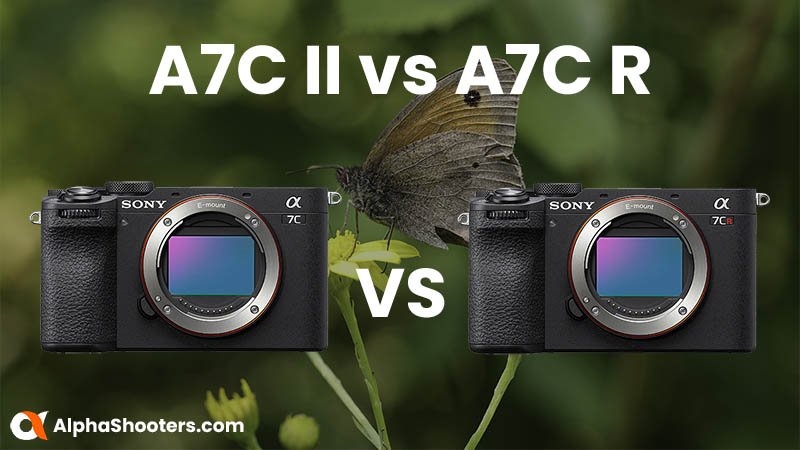
In this article I’ll be taking a look at the key differences between the Alpha 7CII and Alpha 7CR compact mirrorless cameras as well as what they share in common.
I’ve also included a complete specification comparison as well as links to helpful guides and resources for each camera.
Table of Contents[Hide][Show]
Key Feature Differences
Despite these two cameras being very similar there are some key differences that you should know about.
Sensor
Although both cameras feature a full-frame Back-illuminated Exmor R™ CMOS image sensor sensor there is a difference in the number of pixels.
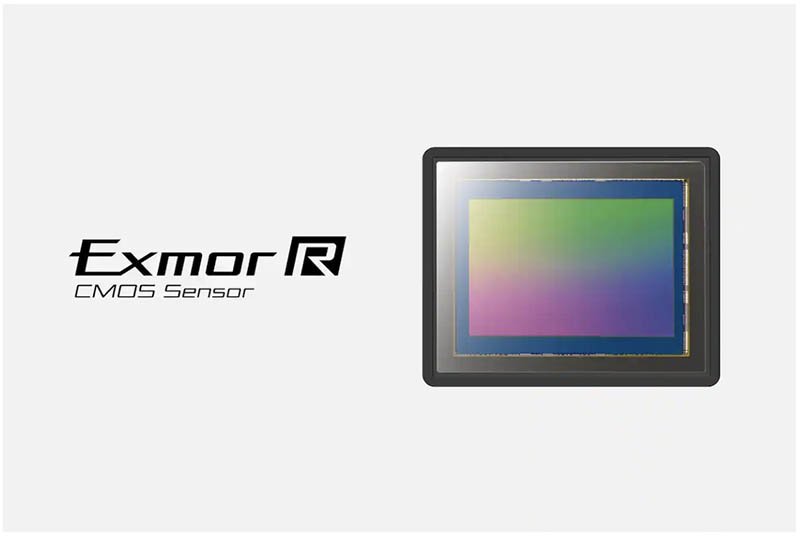
The A7C II has a 33.0 MP sensor with a low-pass filter, whereas the A7C R has a larger 61.0 MP sensor and no low-pass filter.
APS-C / Super 35 Mode
Both cameras feature an APS-C / Super 35 Mode.
The A7C II with its 33 megapixel sensor has an APS-C image size of 14 MP (4608 x 3072).
The larger 61.0 MP sensor in the A7C R means that when you switch into APS-C / Super 35 Mode you’ll still be shooting a 26.2 MP (6240×4160) image.
ISO Sensitivity
There is a difference in ISO sensitivity between the cameras, with the A7C II having a much higher ISO range for both stills and movies.
| A7C II | A7C R | |
|---|---|---|
| Normal ISO (Stills): | ISO 100 – 51200 | ISO 100 – 32000 |
| Expanded ISO (Stills): | ISO 50 – 204800 | ISO 50 – 102400 |
| Normal ISO (Movies): | ISO 100 – 51200 | ISO 100 – 32000 |
| Expanded ISO (Movies): | ISO 100 – 102400 |
Movies
Both cameras are able to record 4K video in 10-bit 4:2:2 internally and feature an extensive range of settings and profiles such as S-Log3, HLG, and S-Cinetone.
However due to the difference in sensor size there are some important differences when it comes to cropping.
The A7C II can capture 4K30p by oversampling from a 7K region of its sensor with zero crop. 4K 50/60p is however only possible when using Super35 mode (APS-C crop) which introduces a 1.5x crop.
The A7C R on the other hand is able to capture 4K video up to 50 / 60p with a 1.2x crop, however this is achieved using the line-skipping method and the footage won’t be as detailed as the oversampled footage from the A7C II.
There’s also the option of full-width, 4K at up to 30p but again this is achieved through line-skipping.
Alternatively you can capture oversampled 4K at up to 30p using APS-C/Super 35 mode but this comes with a 1.5x crop.
One other big difference that is definitely worth mentioning is that the A7C R also supports 16-bit RAW HDMI output to devices like the Atomos Ninja V, this is not possible with the A7C II.
Pixel Shift Multi-Shooting
Only the Sony A7C R includes Pixel Shift Multi-Shooting that allows you to capture multiple images (4 or 16 shot) that are later combined using Sony’s Imaging Edge desktop software to create a single image with an incredible amount of detail.
Image size after compositing is approx. 60.2 million (9504 x 6336) pixels for 4-image shots, and approx. 240.8 million pixels (19008 x 12672) for 16-image shots.
This same feature is available on the A7R V and is demonstrated in the following video:
Drive Speed and Buffer
The A7C II can shoot at up to 10 fps using either its Mechanical (Electronic-First Curtain Shutter (EFCS) or Electronic Shutter.
The A7C R is a little shower and can shoot up to 8 fps with its Mechanical (Electronic-First Curtain Shutter (EFCS) or 7 fps with its Electronic Shutter.
The buffer capacity also varies between cameras. The following table illustrates the number of shots that can be taken by file format before the buffer is full.
| JPEG Extra Fine | JPEG Fine | Uncompressed RAW | Compressed RAW | Lossless Compressed RAW | HEIF | |
|---|---|---|---|---|---|---|
| A7C II | 88 | Over 1000 | 18 | 44 | 27 | Over 1000 |
| A7C R | 48 | 320 | 14 | 36 | 16 |
Autofocus
Both cameras feature the latest autofocus systems with an AI processor. The only differences worth nothing here are the number of phase detection points.
The A7C II features 759 phase detection points covering approximately 94% of the image area when shooting stills. For shooting movies this reduces to a maximum of 627 points.

The A7C R features 693 phase detection points covering approximately 79% of the image area when shooting stills & movies.
Sony GP-X2 Grip Extension
Sony has created a grip extension for the A7C II and A7C R.
However, with the A7C R the grip extension is included in the price. With the A7C II you’ll need to purchase it separately for $158.00 (Check Price at B&H Photo).

Key Features In Common
Both cameras share a large number of features in-common. Let’s take a closer look at those worth mentioning.
Shutter
Both cameras feature both a Mechanical and Electronic shutter.
However, it’s important to note that despite Sony labelling it as a “mechanical shutter” neither camera has a full mechanical shutter. Instead they make use of an electronic-first curtain shutter (EFCS), in addition to the full electronic shutter.
With the mechanical shutter the maximum shutter speed is limited to 1/4000s. With the electronic shutter this increases to 1/8000s.
There are some disadvantages to using an electronic-first curtain shutter in place of a full mechanical shutter. These can include distorted images when shooting at faster shutter speeds and also less attractive bokeh but this is highly subjective. Also artificial lights can introduce banding.
I’d recommend watching this video from Mark Galer who explains in a lot more detail the issues when using EFCS.
Both cameras allow you to set the shutter speed to a maximum of 30 seconds when using Bulb Mode. You can set longer shutter times but only when using the mechanical shutter.
Camera Bodies & Controls
The bodies are very similar and you’d be hard pushed to tell the difference between them if it wasn’t for the model designation on the front and top of each camera.
They share identical dimensions and practically the same weight (514g for the A7C II, 515g for the A7C R). Both are available in black or silver and constructed with a magnesium alloy chassis that is both dust and moisture resistant.
Sony A7C II
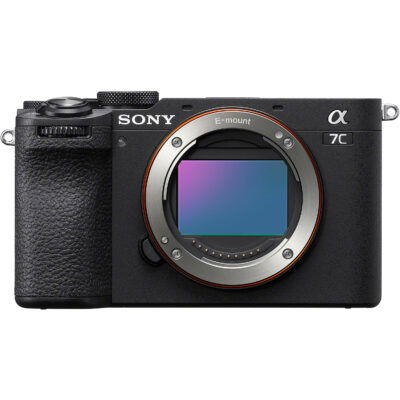
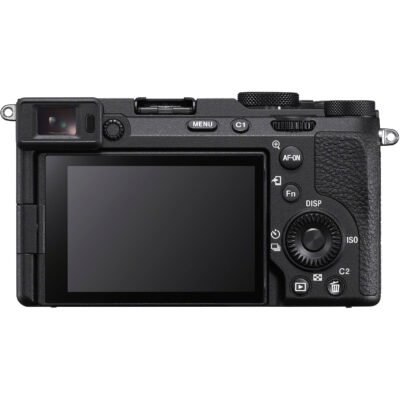

Sony A7C R

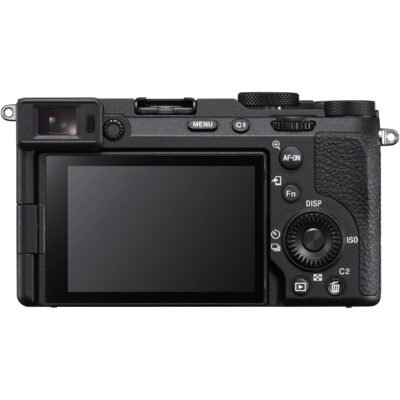
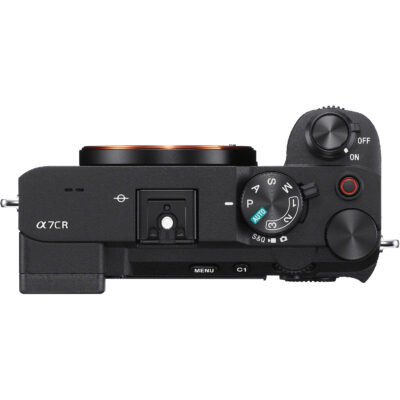
In-Body Stabilization (IBIS)
Both cameras feature Sony’s 5-axis in-body optical image stabilization (IBIS) with 7 stops of compensation.
IBIS detects and compensates for camera shake along five different axes, including angular (pitch and yaw), horizontal, vertical and rotational, for stabilization equivalent to a 5-step faster shutter speed setting.
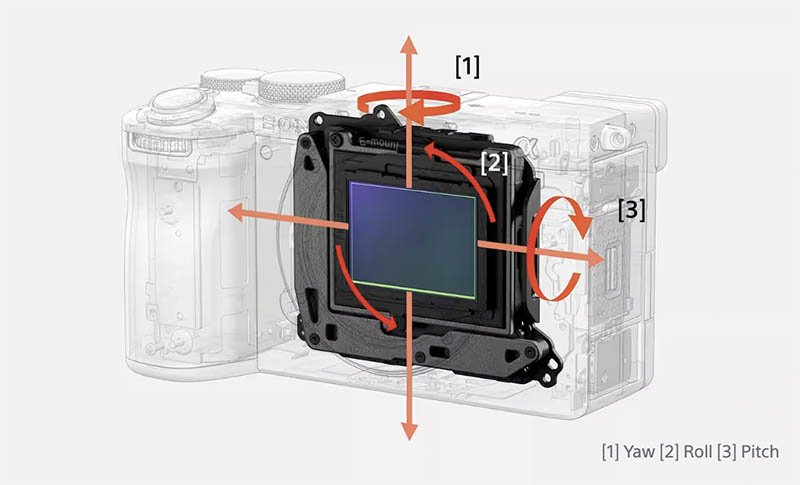
As well as IBIS they also feature active mode stabilization for movie shooting and are compatible with Sony Catalyst software, enabling post-production stabilization using gyro sensor data.
Still Image Recording Formats
Both cameras offer compressed and uncompressed RAW 14-bit files along with JPEG and HEIF file types.
There are also three lossless raw compression image sizes (S/M/L) as well as a Light image quality selection that generates less data for JPEG and HEIF images.
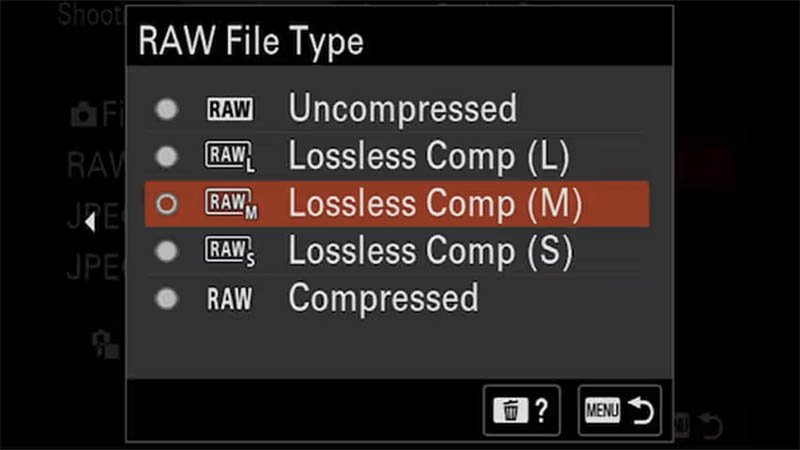
Autofocus
Both cameras are equipped with an AI processing unit that greatly increases AF performance compared to models with an AI processing unit.
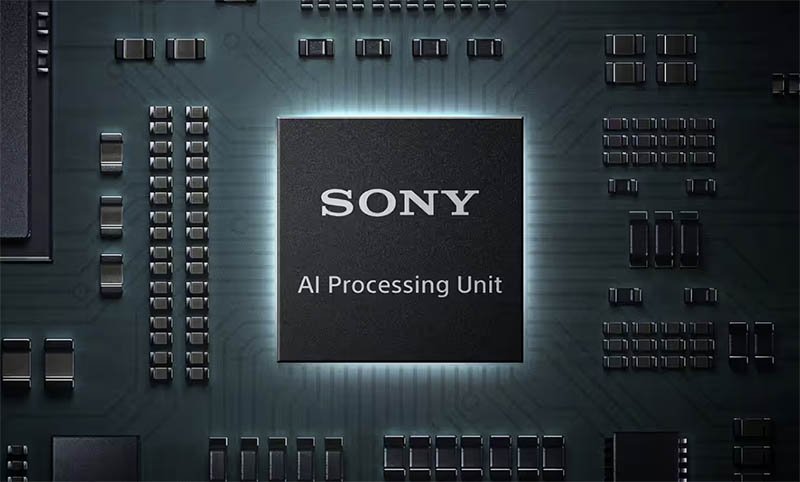
Both cameras can recognize humans, animals, birds, insects, cars, trains and airplanes.
| Subject Detection | A7C II / A7C R |
|---|---|
| Humans | Face, Head, Eyes, Body |
| Animals | Body, Head, Eyes |
| Birds | Body, Head, Eyes |
| Insects | Yes |
| Cars | Yes |
| Trains | Yes |
| Airplanes | Yes |
They also feature human pose estimation technology that uses a skeleton-based model, enabling the cameras to recognise not just eyes, but also body and head positions with high precision.
Electronic Viewfinder and LCD Display
Both cameras feature exactly the same electronic viewfinders (EVF) and LCD displays.
Electronic Viewfinder (EVF)
Each camera features a 2.36 million dot OLED viewfinder with a magnification of 0.70x.

LCD Display
Both cameras feature a 2.95 inch (3.0-type) TFT display with a resolution of 1 036 800 dots.
Both displays are vari-angle touch displays with an opening angle of approx. 176 deg and a rotation angle of approx. 270 deg.

Menu and Touch Control
Both cameras benefit from the latest menu design and improved touch functionality.

You can navigate the menus by touch and swiping in from the left or right edge of the shooting display to reveal touch icons that allow quick changes to the shooting mode and other settings. The function (Fn) menu can also be displayed by a simple swipe-up.
A screen reader function also reads text on the menu screens aloud, with volume and reading speed adjustable as needed.
Connectivity
Both cameras feature the same connectivity options.
- 2.4 / 5 Ghz Wi-Fi
- Bluetooth standard Ver. 4.2
- Micro HDMI port (type D micro jack)
- SuperSpeed USB-C 5 Gbps (USB 3.2)
- Microphone jack (3.5 mm)
- Headphone jack (3.5 mm)
- Multi Interface (MI) Shoe with digital audio
Both cameras support Sony’s Creators App for remote control and file management.
The Sony RMT-P1BT Bluetooth Remote (B&H Photo | Amazon) is also supported by both cameras.
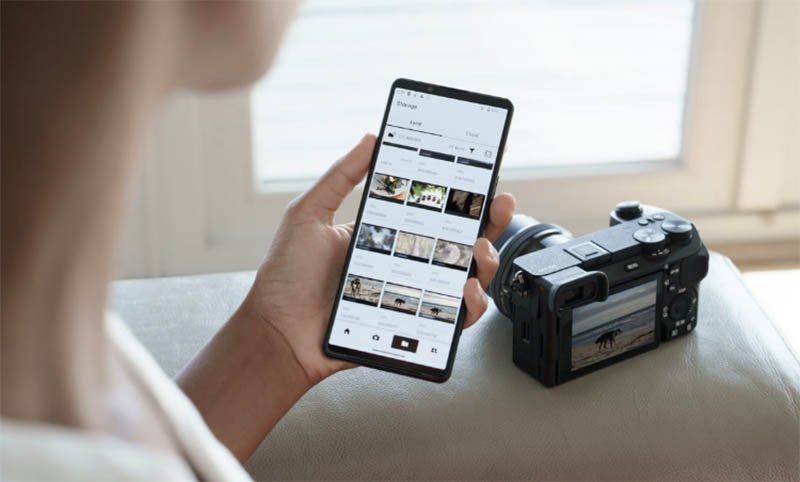
Live Streaming / Webcam
Both cameras can also function as a 4K (2160p) webcam with advanced AF that makes online meetings and live streaming events even smoother. Eye tracking is also possible.
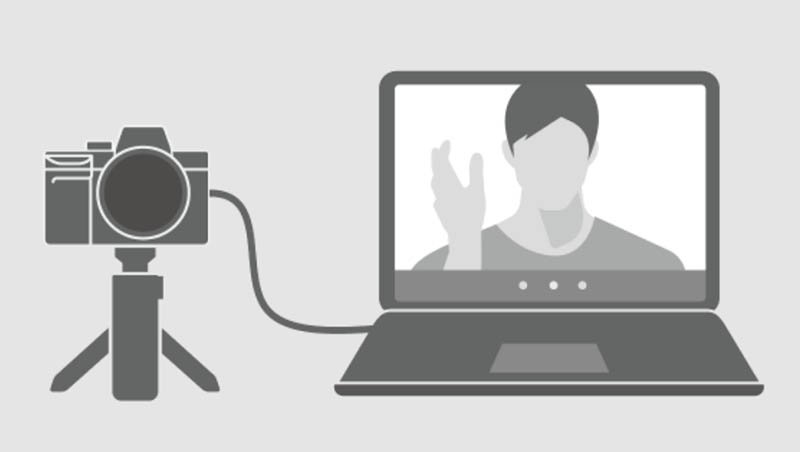
Firmware Updates
Both cameras enable firmware updates via memory card.
Memory Cards
Both cameras feature a single memory card slot on the side of the camera that supports UHS-I / II SD cards.
Please visit my Sony A7C II Memory Card Guide to learn more about the best memory cards for the A7C II. Or my Sony A7C R Memory Card Guide for the A7C R.
Battery
Both cameras utilize the Sony NP-FZ100 battery.

Additional Features In Common
There are many more features that these two cameras share in-common, these include:
- BIONZ XR processor
- Stills / Movies / S&Q Dial
- Focus Map
- AF Assist
- Real-time Tracking for Movies
- Active Mode Enhanced Movie Image Stabilization
- Breathing Compensation
- Import User LUT files
- Auto Framing
- In-camera Time-Lapse / Interval Shooting
- Creative Look
- Full Time DMF
- Focus bracketing
- Shutter When Power Off
- USB Charging + Power Delivery
- AF precision down to light levels as low as EV -4.0 in AF-S mode (ISO 100 equivalent, F2.0 lens)
Price Comparison
| Sony A7C II | Sony A7C R | |
|---|---|---|
| MRSP Body-Only | $2,198.00 / £2,099.00 | $2,998.00 / £3,199.00 |
| Check Prices / Deals | B&H Photo | Amazon | B&H Photo | Amazon |
What’s in the Box
The box contents of each camera are similar except the A7C R also includes the Sony GP-X2 grip extender (B&H Photo).
Sony has excluded the USB Adaptor and Micro USB cable (B&H Photo) from both camera boxes. But hopefully you already have one at home.
| Sony A7C II | Sony A7C R |
|---|---|
| Sony A7C II Body | Sony A7C R Body |
| Rechargeable Battery: NP-FZ100 | Rechargeable Battery: NP-FZ100 |
| Shoulder strap | Shoulder strap |
| Body cap | Body cap |
| Accessory shoe cap | Accessory shoe cap |
| GP-X2 grip extender | |
Conclusion
Both cameras are very similar and unless you really require 61 MP pixels then the A7C II is probably going to tick all of your boxes and for around $800 less than the A7C R.
If you are a movie shooter then the 16-bit external RAW option might persuade you to go with the A7C R, but you would be sacrificing some image quality when shooting in full-frame.
Please let me know in the comments below if you found this comparison helpful and which camera you are leaning towards.
Table of Contents[Hide][Show]
Reviews
To learn more about these two cameras I’d recommend watching this review from Chris and Jordan.
Sony A7C II Guides & Resources
Sony A7C R Guides & Resources
Complete Feature & Spec Comparison
To make sure nothing is missed here’s a complete comparison of the features and specifications of each camera.
Key Features
| Feature | Sony A7CII | Sony A7CR |
|---|---|---|
| Announced | August 29th, 2023 | August 29th, 2023 |
| Camera Type | Mirrorless | Mirrorless |
| Sensor Size | 35mm full frame (35.9 x 23.9 mm) | 35mm full frame (35.7 x 23.8 mm) |
| Sensor Type | Back-illuminated Exmor R™ CMOS image sensor | Back-illuminated Exmor R™ CMOS image sensor |
| Resolution | 33 MP | 61 MP |
| Sensor Pixel Size | 5.12µm | 3.76µm |
| Pixel Dimensions | 7008 x 4672 | 9504 x 6336 |
| Image Processor | BIONZ XR™ | BIONZ XR™ |
| Low Pass Filter | Yes | No |
| IBIS (In-Body Image Stabilization) | Yes (7 Steps) | Yes (7 Steps) |
| Active Mode Stabilization | Yes | Yes |
| Base ISO Stills | ISO 100 | ISO 100 |
| Max Native ISO Stills | ISO 51200 | ISO 32000 |
| Extended ISOs Stills | ISO 204800 | ISO 102400 |
| High-Resolution Sensor Shift (Pixel Shift) | No | Yes |
| Focus Bracketing | Yes | Yes |
| Full Time DMF | Yes | Yes |
| Pre-Shoot Burst Mode | No | No |
| Fastest Shutter Speed (Mechanical Shutter / Electronic First Curtain) | 1/4000 sec | 1/4000 sec |
| Fastest Shutter Speed (Electronic Shutter) | 1/8000 sec | 1/8000 sec |
| Longest Shutter Speed | 30 seconds + Bulb | 30 seconds + Bulb |
| Continuous Shooting (Mechanical Shutter) | 10 FPS | 8 FPS |
| Continuous Shooting (Electronic Shutter) | 10 FPS | 7 FPS |
| Notes for High FPS Shooting | The maximum speed is only possible shooting compressed RAW, JPEG or HEIF file types. Live View reduces to 8 FPS. | The maximum speed is only possible shooting compressed RAW, JPEG or HEIF file types. |
| Buffer Size (RAW Uncompressed) | 18 | 14 |
| Buffer Size (RAW Compressed) | 44 | 36 |
| Buffer Size (RAW Lossless Compressed) | 27 | 16 |
| Buffer Size (JPEG Extra Fine L) | 88 | 48 |
| Buffer Size (JPEG Fine L) | Over 1000 | 320 |
| Buffer Size (HEIF) | – | – |
| Autofocus System | Fast Hybrid AF (phase-detection AF / contrast-detection AF) | Fast Hybrid AF (phase-detection AF / contrast-detection AF) |
| AF Subject Detection | Humans, animals, birds, insects, cars/trains, and airplanes | Humans, animals, birds, insects, cars/trains, and airplanes |
| Autofocus Points (Phase) | 759 | 693 |
| Maximum Low-Light AF Sensitivity (Standardized to f/2, ISO 100) | EV-4 | EV-4 |
| Standard Flash Sync Speed | 1/160 s (35mm full frame), 1/200 s (APS-C) | 1/160 s (35mm full frame), 1/200 s (APS-C) |
| Curtain to Protect Sensor at Shutdown (Shutter Power Off) | Yes | Yes |
| Interval Shooting | Yes | Yes |
| Soft Skin Effect (stills / movies) | Yes | Yes |
| Creative Look | Yes | Yes |
| My Image Style | Yes | Yes |
| Background Defocus | No | No |
| Face Memory | – | – |
Video Specific Features
| Feature | Sony A7CII | Sony A7CR |
|---|---|---|
| Maximum Video Bit Depth (Internal) | 10 bits | 10 bits |
| Maximum Video Bit Depth (External) | 10 bits | 10 bits |
| Raw Video | No | External 16-bit RAW |
| 4K Maximum Frame Rate | 60p/50p | 60p/50p |
| 1080P Maximum Frame Rate | 120p | 120p |
| Additional Video Crop Factor | 1.5x crop at 4K 60p (4K 30p has no additional crop) | 1.24x crop at 4K 60p (otherwise no additional crop) |
| Chroma Subsampling | 4:2:2 | 4:2:2 |
| Video Recording Limit | No | No |
| S-Cinetone | Yes | Yes |
| Picture Profiles (stills/movies) | Yes | Yes |
| Active Stabilization | Yes | Yes |
| Focus Breathing Compensation | Yes | Yes |
| Import User LUT Files | Yes | Yes |
| AI Auto Framing | Yes | Yes |
| Focus Map | Yes | Yes |
| AF Assist | Yes | Yes |
| Time Code (TC) | Yes | Yes |
| In-Camera Time-Lapse Creation | Yes | Yes |
| Framing Stabilizer | – | – |
| Product Showcase Set | – | – |
| Cinematic Vlog Setting | – | – |
| Multiple Face Recognition in Intelligent Auto Mode | – | – |
Physical & Other Features
| Feature | Sony A7CII | Sony A7CR |
|---|---|---|
| Card Slots | 1 | 1 |
| Slot 1 Type | SD (UHS-II / I) | SD (UHS-II / I) |
| Rear LCD Size (Diagonal) | 7.5 cm (3.0-type) type TFT | 7.5 cm (3.0-type) type TFT |
| Rear LCD Resolution | 1 036 800 dots | 1 036 800 dots |
| Articulating LCD | Yes | Yes |
| Touchscreen | Yes | Yes |
| Viewfinder | EVF | EVF |
| Viewfinder Magnification | Approx. 0.70x (with 50 mm lens at infinity, -1 m-1) | Approx. 0.70x (with 50mm lens at infinity, -1 m-1) |
| Viewfinder Resolution | 2 359 296 dots | 2 359 296 dots |
| Voice Memo | No | No |
| Headphone Jack | Yes (3.5 mm Stereo minijack) | Yes (3.5 mm Stereo minijack) |
| Microphone Jack | Yes (3.5 mm Stereo minijack) | Yes (3.5 mm Stereo minijack) |
| Built-in Microphone | Built-in, stereo | Built-in, stereo |
| Built-in Flash | No | No |
| GPS | No | No |
| Bluetooth | Yes (Bluetooth Standard Ver. 4.2 (2.4 GHz band)) | Yes (Bluetooth Standard Ver. 4.2 (2.4 GHz band)) |
| WiFi | Yes (Wi-Fi Compatible, IEEE 802.11a/b/g/n/ac (2.4 GHz band/5 GHz band)) | Yes (Wi-Fi Compatible, IEEE 802.11a/b/g/n/ac (2.4 GHz band/5 GHz band)) |
| USB Type | Yes (SuperSpeed USB 5 Gbps (USB 3.2) compatible) | Yes (SuperSpeed USB 5 Gbps (USB 3.2) compatible) |
| Multi / Micro USB Terminal | No | No |
| HDMI Port | Yes. HDMI micro connector (Type-D) | Yes. HDMI micro connector (Type-D) |
| Multi Interface Shoe | Yes (with Digital Audio Interface) | Yes (with Digital Audio Interface) |
| Battery Type | NP-FZ100 | NP-FZ100 |
| Battery Life Stills (Viewfinder) | 530 frames (CIPA standard) | 490 frames (CIPA standard) |
| Battery Life Stills (Rear LCD) | 560 frames (CIPA standard) | 530 frames (CIPA standard) |
| Battery Life Video Actual (Viewfinder) | 100 minutes (CIPA standard) | 95 minutes (CIPA standard) |
| Battery Life Video Actual (Rear LCD) | 105 minutes (CIPA standard) | 100 minutes (CIPA standard) |
| Weather Sealed | Yes | Yes |
| Weight (Body Only) | Approx. 429 g (0.95 lbs.) | Approx. 430 g (0.96 lbs.) |
| Weight (With Battery & Card) | Approx. 514 g (1.13 lbs.) | Approx. 515 g (1.14 lbs.) |
| Dimensions (LxHxD) | Approx. 124.0 x 71.1 x 63.4 mm, Approx. 124.0 x 71.1 x 58.6 mm (from grip to monitor) / Approx. 5 x 2 7/8 x 2 1/2 inches, Approx. 5 x 2 7/8 x 2 3/8 inches (from grip to monitor) | Approx. 124.0 x 71.1 x 63.4 mm, Approx. 124.0 x 71.1 x 58.6 mm (from grip to monitor) / Approx. 5 x 2 7/8 x 2 1/2 inches, Approx. 5 x 2 7/8 x 2 3/8 inches (from grip to monitor) |
| Operating Temperature | 0 – 40 ℃ / 32 – 104 °F | 0 – 40 ℃ / 32 – 104 °F |
Sony A7C / A7CII / A7CR Forum & Facebook Group
If you are looking for further help and advice on the A7C or would simply like to share your photos and videos, then please head over to our friendly full-frame Forum. If you prefer Facebook then I also run the Sony A7C + A7CII + A7CR Shooters Group.




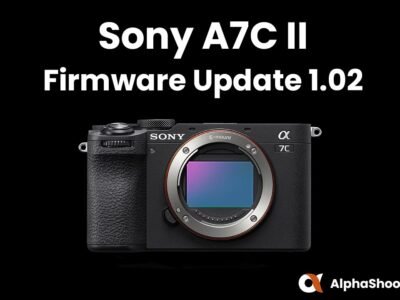


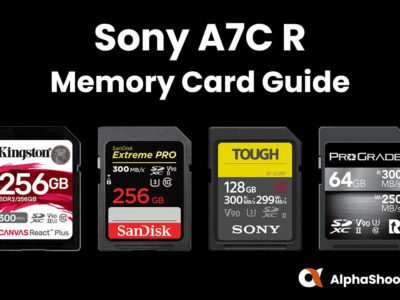


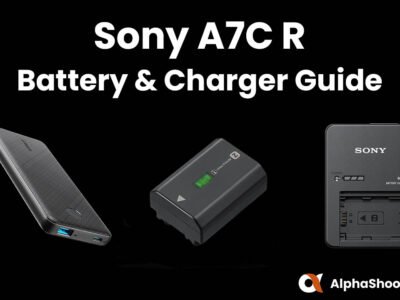
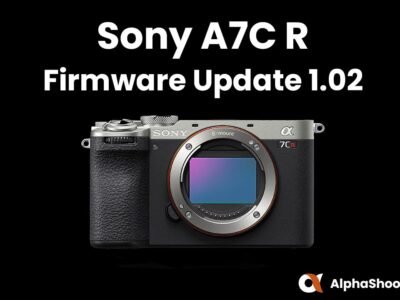


Leave a Reply